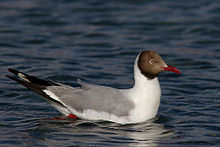- Brown-headed Gull
-
Brown-headed Gull 
Conservation status Scientific classification Kingdom: Animalia Phylum: Chordata Class: Aves Order: Charadriiformes Family: Laridae Genus: Chroicocephalus Species: C. brunnicephalus Binomial name Chroicocephalus brunnicephalus
(Jerdon, 1840, west coast of Indian Peninsula)Synonyms Larus brunnicephalus
The Brown-headed Gull, Chroicocephalus brunnicephalus, is a small gull which breeds in the high plateaus of central Asia from Turkmenistan to Mongolia. It is migratory, wintering on the coasts and large inland lakes of tropical southern Asia. As is the case with many gulls, it has traditionally been placed in the genus Larus.
This gull breeds in colonies in large reedbeds or marshes, or on islands in lakes, nesting on the ground. Like most gulls, it is highly gregarious in winter, both when feeding or in evening roosts. It is not a pelagic species, and is rarely seen at sea far from coasts.
This is a bold and opportunist feeder, which will scavenge in towns or take invertebrates in ploughed fields with equal relish.
The Brown-headed Gull is slightly larger than Black-headed Gull. The summer adult has a pale brown head, lighter than that of Black-headed, a pale grey body, and red bill and legs. The black tips to the primary wing feathers have conspicuous white "mirrors". The underwing is grey with black flight feathers. The brown hood is lost in winter, leaving just dark vertical streaks.
This bird takes two years to reach maturity. First year birds have a black terminal tail band, more dark areas in the wings, and, in summer, a less homogeneous hood.
This is a noisy species, especially at colonies.
References
- ^ BirdLife International (2004). Larus brunnicephalus. 2006. IUCN Red List of Threatened Species. IUCN 2006. www.iucnredlist.org. Retrieved on 5 May 2006. Database entry includes justification for why this species is of least concern
- Birds of India by Grimmett, Inskipp and Inskipp, ISBN 0-691-04910-6
- Pons J.M., Hassanin, A., and Crochet P.A.(2005). Phylogenetic relationships within the Laridae (Charadriiformes: Aves) inferred from mitochondrial markers. Molecular phylogenetics and evolution 37(3):686-699
Gulls (family: Laridae) Genus Larus Pacific Gull • Belcher's Gull • Olrog's Gull • Black-tailed Gull • Heermann's Gull • Common Gull (or Mew Gull) • Ring-billed Gull • California Gull • Great Black-backed Gull • Kelp Gull (or Cape Gull) • Glaucous-winged Gull • Western Gull • Yellow-footed Gull • Glaucous Gull • Iceland Gull • Kumlien's Gull • Thayer's Gull • European Herring Gull • Heuglin's Gull • American Herring Gull • Yellow-legged Gull • Caspian Gull • Vega Gull (or East Siberian Gull / Mongolian Gull) • Armenian Gull • Slaty-backed Gull • Lesser Black-backed GullIchthyaetus Leucophaeus Chroicocephalus Silver Gull • Red-billed Gull • Huahine Gull • Hartlaub's Gull • Brown-hooded Gull • Grey-headed Gull (or Grey-hooded Gull) • Andean Gull • Black-billed Gull • Brown-headed Gull • Black-Headed Gull • Slender-billed Gull • Bonaparte's GullSaundersilarus Hydrocoloeus Rhodostethia Rissa Pagophila Xema Creagrus Categories:- IUCN Red List least concern species
- Gulls
- Chroicocephalus
- Fauna of Central Asia
- Birds of Pakistan
Wikimedia Foundation. 2010.

